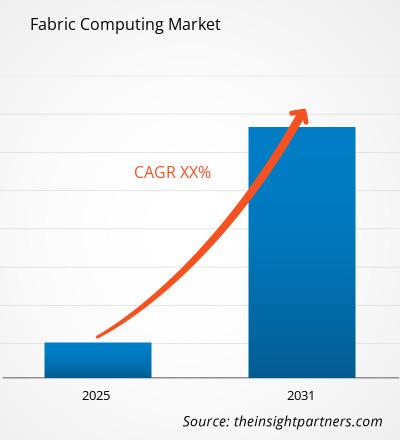MARKET INTRODUCTION
Fabric computing is a method of connecting a set of computing nodes and links. In the data center, fabric computing is a high-performance computing system that combines server, storage, and networking technology. Fabric computing is becoming more popular, particularly among large enterprises, due to its ability to scale reliably, provide parallel processing services, and provide dynamic and flexible reconfiguration. One of the major factors driving the growth of the fabric computing market is the growing virtualization of data center network infrastructure to increase agility, performance, and cost.
MARKET DYNAMICS
One of the major factors driving the growth of the fabric computing market is the growing virtualization of data center network infrastructure to increase agility, performance, and cost. Furthermore, the growing demand for cloud technology is propelling the fabric computing market forward. Also, the expansion of network infrastructure to support services and new applications are creating potential growth opportunities for fabric computing market. Whereas, one of the biggest challenges of fabric computing is vendor lock-in and lack of technology penetration in some of the low income nations are expected to restrain market growth during the forecast period.
MARKET SCOPE
The "Global Fabric Computing Market Analysis To 2031" is a specialized and in-depth study of the technology, media and telecommunications industry with a special focus on the global market trend analysis. The fabric computing market report aims to provide an overview of the fabric computing market with detailed market segmentation by component, enterprise size, end user, and geography. The global fabric computing market is expected to witness high growth during the forecast period. The report provides key statistics on the market status of the leading fabric computing market players and offers key trends and opportunities in the market.
MARKET SEGMENTATION
The global fabric computing market is segmented on the basis of component, enterprise size, end user. Based on component, the fabric computing market is segmented into: software and services. On the basis of enterprise size, the fabric computing market is segmented into: SMEs and large enterprises. Similarly, based on end user, the fabric computing market is segmented into: IT and telecommunications, automotive, consumer electronics, retail, and others.
REGIONAL FRAMEWORK
The report provides a detailed overview of the industry including both qualitative and quantitative information. It provides an overview and forecast of the global fabric computing market based on various segments. It also provides market size and forecast estimates from the year 2021 to 2031 with respect to five major regions, namely; North America, Europe, Asia-Pacific (APAC), Middle East and Africa (MEA) and South & Central America. The fabric computing market by each region is later sub-segmented by respective countries and segments. The fabric computing market report covers the analysis and forecast of 18 countries globally along with the current trend and opportunities prevailing in the region.
The report analyzes factors affecting the fabric computing market from both demand and supply side and further evaluates market dynamics affecting the market during the forecast period i.e., drivers, restraints, opportunities, and future trend. The report also provides exhaustive PEST analysis highlighting factors affecting the fabric computing market in these regions.
MARKET PLAYERS
The reports cover key developments in the fabric computing market as organic and inorganic growth strategies. Various companies are focusing on organic growth strategies such as product launches, product approvals and others such as patents and events. Inorganic growth strategies activities witnessed in the market were acquisitions, and partnership & collaborations. These activities have paved way for the expansion of business and customer base of market players. The market players from fabric computing market are anticipated to lucrative growth opportunities in the future with the rising demand for filter products in the global market. Below mentioned is the list of few companies engaged in the fabric computing market.
The report also includes the profiles of key companies along with their SWOT analysis and market strategies in the fabric computing market. In addition, the report focuses on leading industry players with information such as company profiles, components, and services offered, financial information of the last 3 years, the key development in the past five years.
- Atos
- Avaya
- CA Technologies
- Cisco Systems, Inc.
- Hewlett Packard Enterprise
- IBM Corporation
- Microsoft Corporation
- Oracle Corporation
- TIBCO Software Inc
- Unisys
Fabric Computing Report Scope
| Report Attribute | Details |
|---|---|
| Market size in 2024 | US$ XX million |
| Market Size by 2031 | US$ XX Million |
| Global CAGR (2025 - 2031) | XX% |
| Historical Data | 2021-2023 |
| Forecast period | 2025-2031 |
| Segments Covered |
By Component
|
| Regions and Countries Covered | North America
|
| Market leaders and key company profiles |
- Historical Analysis (2 Years), Base Year, Forecast (7 Years) with CAGR
- PEST and SWOT Analysis
- Market Size Value / Volume - Global, Regional, Country
- Industry and Competitive Landscape
- Excel Dataset



Report Coverage
Revenue forecast, Company Analysis, Industry landscape, Growth factors, and Trends

Segment Covered
This text is related
to segments covered.

Regional Scope
North America, Europe, Asia Pacific, Middle East & Africa, South & Central America

Country Scope
This text is related
to country scope.
Trends and growth analysis reports related to Technology, Media and Telecommunications : READ MORE..
The List of Companies
1. Atos
2. Avaya
3. CA Technologies
4. Cisco Systems, Inc.
5. Hewlett Packard Enterprise
6. IBM Corporation
7. Microsoft Corporation
8. Oracle Corporation
9. TIBCO Software Inc
10. Unisys
1. Atos
2. Avaya
3. CA Technologies
4. Cisco Systems, Inc.
5. Hewlett Packard Enterprise
6. IBM Corporation
7. Microsoft Corporation
8. Oracle Corporation
9. TIBCO Software Inc
10. Unisys

 Get Free Sample For
Get Free Sample For